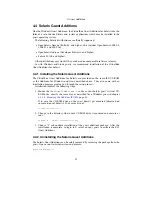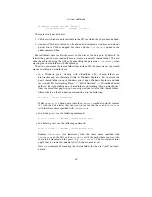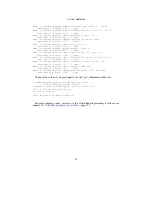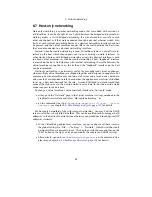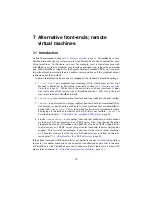
5 Virtual storage
As the virtual machine will most probably expect to see a hard disk built into its virtual
computer, VirtualBox must be able to present “real” storage to the guest as a virtual
hard disk. There are presently three methods in which to achieve this:
1. Most commonly, VirtualBox will use large image files on a real hard disk and
present them to a guest as a virtual hard disk. This is described in chapter
5.2
,
Disk image files (VDI, VMDK, VHD)
, page
77
.
2. Alternatively, if you have iSCSI storage servers, you can attach such a server to
VirtualBox as well; this is described in chapter
5.5
,
iSCSI servers
, page
80
.
3. Finally, as an experimental feature, you can allow a virtual machine to access
one of your host disks directly; this advanced feature is described in chapter
9.10
,
Using a raw host hard disk from a guest
, page
135
.
Each such virtual storage device (image file, iSCSI target or physical hard disk) will
need to be connected to the virtual hard disk controller that VirtualBox presents to a
virtual machine. This is explained in the next section.
5.1 Hard disk controllers: IDE, SATA (AHCI), SCSI
In a real PC, hard disks and CD-ROM/DVD drives are connected to a device called
hard disk controller which drives hard disk operation and data transfers. VirtualBox
can emulate the three most common types of hard disk controllers typically found in
today’s PCs: IDE, SCSI and SATA (AHCI).
1
•
IDE (ATA)
controllers have been in use since the 1980s. Initially, this type of
interface worked only with hard disks, but was later extended to also support
CD-ROM drives and other types of removable media. In physical PCs, this stan-
dard uses flat ribbon parallel cables with 40 or 80 wires. Each such cable can
connect two devices to a controller, which have traditionally been called “master”
and “slave”. Typical hard disk controllers have two connectors for such cables;
as a result, most PCs support up to four devices.
In VirtualBox, each virtual machine has one IDE controller enabled by default.
You can therefore connect up to four virtual storage devices to a virtual ma-
chine. Since one of these (the secondary master) is always configured to be a
1
SATA support was added with VirtualBox 1.6; experimental SCSI support was added with 2.1 and fully
implemented with 2.2.
75







